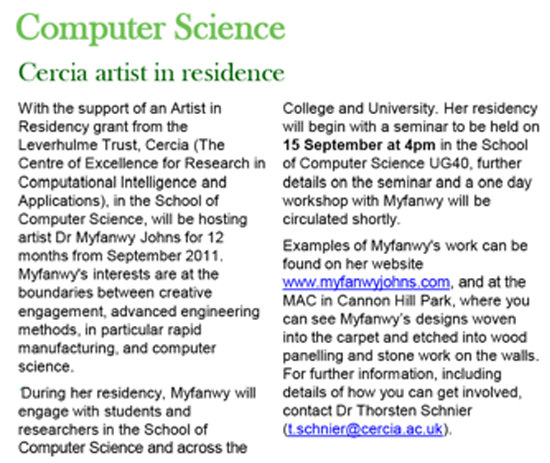
In September 2011 I will start a ten-month Artist in Residence funded by the Leverhulme Trust. The residency is hosted by CERCIA, The Centre of Excellence for Research in Computational Intelligence and Applications (Dr Thorsten Schnier), at the School of Computer Science, University of Birmingham.
I will be investigating the function of ornament and its transformative quality on architectural space. An ongoing interest of my practice is to investigate interior and exterior architectural structures that initiate a public interface with ornamentation in the built environment. Particular interests include the expression of materials and integrating pattern into essential substrates. My explorations of surface design include working with historic pattern; pattern enables my work to connect with previous and future generations. My research interests include the application of computer image transfer technology to new and traditional materials to integrate decoration into the structure.
The aim of the Residency is to research the boundaries between creative engagement, advanced engineering methods and computer science to create unique outcomes that have the potential to advance thinking towards use of ornamentation. My PhD research led to the investigation of digital image transfer techniques and its significance to the function of ornamentation in architecture. It is this individuality of outcome that interests me, computers and digital manufacturing enable mass customisation as opposed to mass production. A common interest with the computer science department is the creation, variation and use of patterns in a range of contexts. The host has in the past explored the computational formulation and parameterization of patterns, and I have explored repetition of forms and their decorative applications. The mathematical formulation of patterns found in nature, historic artifacts, environmental data, and other sources, and their use in decorative art, will therefore form one focus of the collaborative work. Patterns also play an important role in human computer interaction (HCI) and software design; we will look at exploiting some of the implicit knowledge embodied in design practice.
I plan to work closely with the Visual and Spatial Technology Centre (VISTA) and the Interdisciplinary Research Centre (IRC) in Metallurgy and Materials Processing. Visual experimentation is likely to use the potential for 3D scanning and direct laser fabrication technologies to create unique surface ornamentation and 3-D sculptural objects. The direct laser fabrication technique can produce 3-D components directly from CAD files using a laser beam, which moves following the paths defined by the CAD file whilst metal or ceramic powder is being injected into its focal point.
